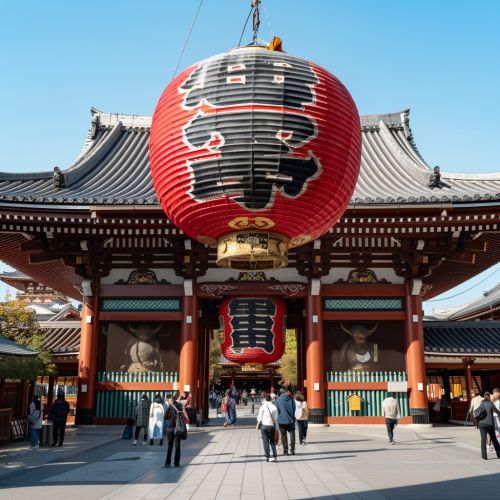Senso-ji Temple: Difference between revisions
(Created page with "== Senso-ji Temple == <div class='only_on_desktop image-preview'><div class='image-preview-loader'></div></div><div class='only_on_mobile image-preview'><div class='image-preview-loader'></div></div> Senso-ji Temple, also known as Asakusa Kannon Temple, is a prominent Buddhist temple located in Asakusa, Tokyo, Japan. It is Tokyo's oldest temple and one of its most significant, attracting millions of visitors annually. The temple is dedicated to Kannon Bosatsu, the Bodh...") |
No edit summary |
||
| Line 1: | Line 1: | ||
== Senso-ji Temple == | == Senso-ji Temple == | ||
[[Image:Detail-93325.jpg|thumb|center|Main hall of Senso-ji Temple in Tokyo, Japan, with a large red lantern hanging from the entrance.]] | |||
Senso-ji Temple, also known as Asakusa Kannon Temple, is a prominent Buddhist temple located in Asakusa, Tokyo, Japan. It is Tokyo's oldest temple and one of its most significant, attracting millions of visitors annually. The temple is dedicated to Kannon Bosatsu, the Bodhisattva of Compassion. | Senso-ji Temple, also known as Asakusa Kannon Temple, is a prominent Buddhist temple located in Asakusa, Tokyo, Japan. It is Tokyo's oldest temple and one of its most significant, attracting millions of visitors annually. The temple is dedicated to Kannon Bosatsu, the Bodhisattva of Compassion. | ||
Revision as of 09:27, 22 June 2024
Senso-ji Temple

Senso-ji Temple, also known as Asakusa Kannon Temple, is a prominent Buddhist temple located in Asakusa, Tokyo, Japan. It is Tokyo's oldest temple and one of its most significant, attracting millions of visitors annually. The temple is dedicated to Kannon Bosatsu, the Bodhisattva of Compassion.
History
The origins of Senso-ji Temple date back to 628 AD, when two fishermen, Hinokuma Hamanari and his brother Takenari, discovered a statue of Kannon in the Sumida River. The village chief, Haji no Nakatomo, recognized the sanctity of the statue and enshrined it, marking the foundation of Senso-ji. The temple was officially established in 645 AD, making it the oldest temple in Tokyo.
Throughout its history, Senso-ji has undergone numerous reconstructions due to natural disasters and wars. The most significant reconstruction occurred after World War II, when the temple was rebuilt following its destruction during the Tokyo air raids.
Architecture
Senso-ji Temple showcases traditional Japanese Buddhist architecture, characterized by its grandiose structures and intricate details. The main hall, or Hondo, is the centerpiece of the temple complex. It houses the revered statue of Kannon, which is not publicly displayed. The Hondo is an exemplary model of Edo-period architecture, featuring a large gabled roof and ornate woodwork.
The Kaminarimon, or "Thunder Gate," serves as the outer gate of Senso-ji. It is one of Tokyo's most iconic landmarks, distinguished by its massive red lantern and statues of Fujin (the god of wind) and Raijin (the god of thunder). Beyond the Kaminarimon lies Nakamise-dori, a bustling shopping street leading to the temple's second gate, the Hozomon.
The Hozomon, or "Treasure House Gate," is another significant structure within the temple complex. It houses a pair of large Nio statues, which are guardian deities, and a collection of sacred texts and artifacts. The gate's upper floor serves as a repository for these treasures.
Cultural Significance
Senso-ji Temple holds immense cultural and religious significance in Japan. It is a major center for the practice of Buddhism and a site of pilgrimage for devotees. The temple's annual festivals, such as the Sanja Matsuri and Hozuki-ichi, attract large crowds and are integral to the cultural fabric of Tokyo.
The Sanja Matsuri, held in May, is one of Tokyo's most famous festivals. It celebrates the three founders of Senso-ji and features elaborate processions, traditional music, and dance performances. The Hozuki-ichi, or Ground Cherry Fair, takes place in July and is known for its vibrant market selling ground cherry plants and other goods.
Rituals and Practices
Visitors to Senso-ji Temple engage in various rituals and practices to seek blessings and good fortune. One of the most common practices is the purification ritual at the chozuya, or water purification pavilion, where visitors cleanse their hands and mouths before entering the temple.
Inside the temple, visitors can offer prayers and incense at the main hall. The act of offering incense, known as senko, is believed to purify the mind and body. Another popular practice is drawing omikuji, or fortune slips, which provide guidance and predictions for the future.
Preservation and Conservation
Senso-ji Temple is a designated Important Cultural Property of Japan, reflecting its historical and cultural value. Efforts to preserve and conserve the temple are ongoing, involving both governmental and private organizations. Regular maintenance and restoration work ensure that the temple remains a vital part of Tokyo's heritage.
The temple's gardens and surrounding areas are also meticulously maintained, providing a serene environment for visitors. The Asakusa Shrine, located adjacent to Senso-ji, is another important cultural site that contributes to the preservation of the area's historical significance.
